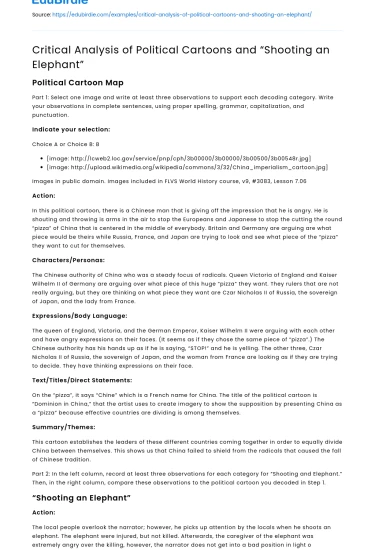Political Cartoon Map
Part 1: Select one image and write at least three observations to support each decoding category. Write your observations in complete sentences, using proper spelling, grammar, capitalization, and punctuation.
Indicate your selection:
Choice A or Choice B: B
Save your time!
We can take care of your essay
- Proper editing and formatting
- Free revision, title page, and bibliography
- Flexible prices and money-back guarantee
- [image: http://lcweb2.loc.gov/service/pnp/cph/3b00000/3b00000/3b00500/3b00548r.jpg]
- [image: http://upload.wikimedia.org/wikipedia/commons/3/32/China_imperialism_cartoon.jpg]
Images in public domain. Images included in FLVS World History course, v9, #3083, Lesson 7.06
Action:
In this political cartoon, there is a Chinese man that is giving off the impression that he is angry. He is shouting and throwing is arms in the air to stop the Europeans and Japanese to stop the cutting the round “pizza” of China that is centered in the middle of everybody. Britain and Germany are arguing are what piece would be theirs while Russia, France, and Japan are trying to look and see what piece of the “pizza” they want to cut for themselves.
Characters/Personas:
The Chinese authority of China who was a steady focus of radicals. Queen Victoria of England and Kaiser Wilhelm II of Germany are arguing over what piece of this huge “pizza” they want. They rulers that are not really arguing, but they are thinking on what piece they want are Czar Nicholas II of Russia, the sovereign of Japan, and the lady from France.
Expressions/Body Language:
The queen of England, Victoria, and the German Emperor, Kaiser Wilhelm II were arguing with each other and have angry expressions on their faces. (It seems as if they chose the same piece of “pizza”.) The Chinese authority has his hands up as if he is saying, “STOP!” and he is yelling. The other three, Czar Nicholas II of Russia, the sovereign of Japan, and the woman from France are looking as if they are trying to decide. They have thinking expressions on their face.
Text/Titles/Direct Statements:
On the “pizza”, it says “Chine” which is a French name for China. The title of the political cartoon is “Dominion in China,” that the artist uses to create imagery to show the supposition by presenting China as a “pizza” because effective countries are dividing is among themselves.
Summary/Themes:
This cartoon establishes the leaders of these different countries coming together in order to equally divide China between themselves. This shows us that China failed to shield from the radicals that caused the fall of Chinese tradition.
Part 2: In the left column, record at least three observations for each category for “Shooting and Elephant.” Then, in the right column, compare these observations to the political cartoon you decoded in Step 1.
“Shooting an Elephant”
Action:
The local people overlook the narrator; however, he picks up attention by the locals when he shoots an elephant. The elephant were injured, but not killed. Afterwards, the caregiver of the elephant was extremely angry over the killing, however, the narrator does not get into a bad position in light of the fact that the elephant had killed someone.
Characters/Personas:
The storyteller/narrator is the main character in the story. He is the sub-divisional cop in Moulmein in the lower Burma. He is a British man who is deeply hated by locals, bet her ignores them as opposed to feeding into it.
Expressions/Body Language:
The narrator indicated negative feelings all throughout the story. He did not acknowledge how the Burmese people mock him and disrespect him. However, he identifies them because of pitiless treatment they get from the British. He gets the opportunity to prove himself by shooting an elephant. He knew the elephant was a pure creature and he did not want to do it, but was forced to and was upset when he did do it.
Summary/Themes:
The elephant symbolized guilt that robbed its life since it was far as anyone knows a threat to the population as a whole, however it was not ready to shield itself. Shooting an Elephant'e.stic. Erimplistic. Errors in conventions.aretten using correct English conventions.sentences.
Comparison to Political Cartoon
Action:
In this political cartoon, the Chinese authority is throwing his hands up as if he was angry and dissatisfied because he cannot prevent the settlers from dividing China. The colonists holding knifes ignore him, conflicting and how the Burmese overlooked the narrator. Queen Victoria of England and Kaiser Wilhelm II of Germany are arguing over what piece of this huge “pizza” they wanted.
Characters/Personas:
Britain is represented by Queen Victoria, Germany is represented by Kaiser Wilhelm II, Russia is represented by Czar Nicholas II of Russia, Japan is represented by sovereign, and France is represented by a woman.
Expressions/Body Language:
The Chinese authority is frantically waving his arms around showing us that he is scared. Queen Victoria is surprised as Kaiser Wilhelm II drives a cut to the “pizza”, speaking to Germany’s forceful partialities. Czar Nicholas II, the sovereign of Japan, and the woman from France are just thinking and debating on which piece they want. China was taking prisoner by these other countries.
Summary/Themes:
The “pizza” that the radicals are cutting into is named as “Chine” which is French for China. The artist uses to create imagery to show the supposition by presenting China as a “pizza” because effective countries are dividing is among themselves






 Stuck on your essay?
Stuck on your essay?

